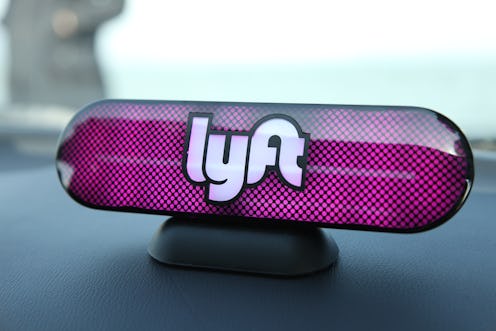
From the time we're old enough to be out and about, we're told not to get in cars with strangers under any circumstances, no matter what. But in our modern-day, millennial, semi-adult lives, we've pretty much abandoned that instinct altogether and thrown caution to the wind — so long as the stranger with a car was specifically summoned by us through a ride-sharing app, of course. That said, safety still needs to be our priority — and as reported by The Verge, Lyft just announced it's adding a panic button to its app for riders to use in case an emergency does take place during a ride, along with some other new safety measures designed to help keep riders safe.
Lyft's new panic button — the addition of which was announced by the company on Tuesday, May 21, according to The Verge — will allow riders to call 911 directly from the app in case of an emergency, making it easier to get help and have their location tracked. According to The Verge, the app added a similar panic button feature for drivers in late 2018. Major ride-share competitor Uber has been on this train for a while now, too, as they reportedly rolled out their app's panic button in May of last year.
Along with the addition of a panic button for riders, the app has also apparently enlarged the depiction of the driver's license plate number in the app in an effort to encourage riders to take extra care to check that they're getting into the correct vehicle. Additionally, the company will be upping its driver education and awareness by offering them sexual harassment prevention trainings to help curb the frightening number of sexual assault accusations made against ride-share drivers. It's also now required that passengers provide feedback on any driver rating that dips below 4 stars — so that the feedback can be shared anonymously with the driver by the company and hopefully addressed in future rides.
While ridesharing apps are part of our everyday lives at this point, it's easy to forget sometimes that technically, we're still getting in an enclosed, moving vehicle with a perfect stranger when we use them — not to mention that if you're not careful about checking who's picking you up and in what vehicle, there's a chance you could get into the wrong car.
And this kind of mistake is more than just annoying — it can be a life-threatening emergency. In April, a 21-year-old college student in South Carolina was reportedly found dead after getting into a vehicle that she mistook for her Uber ride. The driver of the vehicle was arrested and charged with murder and kidnapping, according to ABC News. In another case that took place just this month, an Uber driver in California was reportedly arrested after being accused of trying to kidnap and rape two passengers.
As unfortunate as it is to have to stay this vigilant about our own safety, it is at least nice to know there are measures we can all take to make our Lyft and Uber rides safer, panic button or not. Firstly, double-checking that the license plate and driver image in the app matches what (and who) rolls up to pick you up is a must (and Lyft's newly-enlarged license plate number listings should help with that). You should also ensure that the driver knows your name off the bat, as it will always show up for them in the app if they're legit. And of course, stay conscientious — keep an eye on the route and make sure your driver stays on-course (if you're going somewhere new, don't hesitate to route the path on your own phone to keep tabs!). If your driver appears to be driving elsewhere, then clearly something is probably off.
Staying aware and cautious is a must, and Lyft's recent safety updates — including its panic button — are much-needed to help ensure that both drivers and passengers are protected in the commonplace but pretty dang vulnerable situations that we put ourselves in when we use ride-share apps. While everyone hopes they'll never have to use a "panic button," it's a step in the right direction to know it's there just in case.